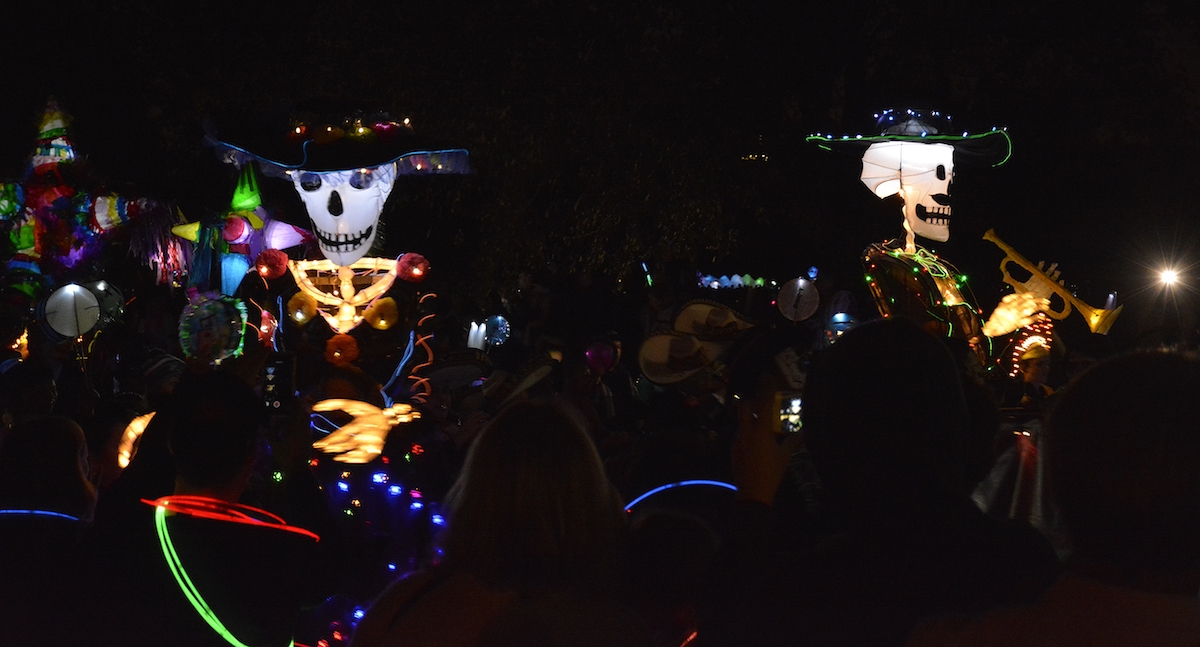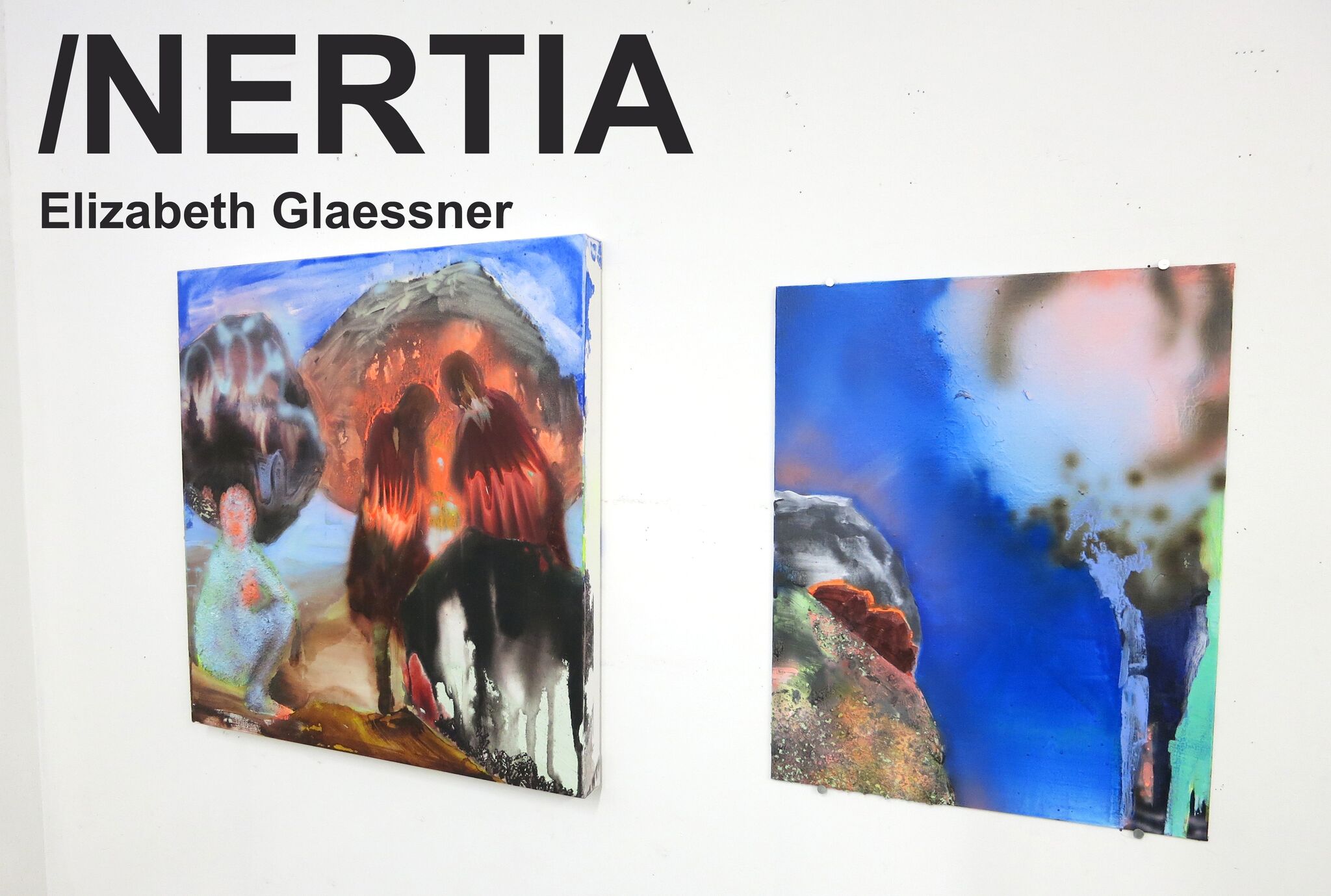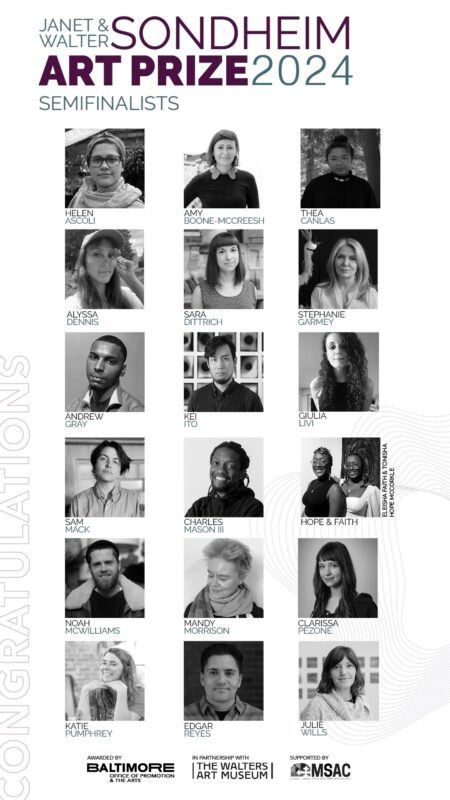A Studio Visit with NY-based Painter Elizabeth Glaessner by Amy Boone-McCreesh
I have been fortunate to receive a wave of studio time this year. With prolonged working sessions and a lot of time spent alone, I find myself thinking a lot about this thing we all call a studio practice. To those outside the creative world, it must seem like such a bizarre existence. And they aren’t wrong; working alone, creating problems for ourselves, and solving those problems to our liking really is a strange and wonderful way to move through life.
These thoughts prompted the studio visit series I’ve titled Inertia. I keep wondering how we all manage to keep going, to keep making work under all kinds of circumstances. For some of us, it’s too hard not to, but that still doesn’t make it easy. In an attempt to demystify this process for myself, I am reaching out to others within the context of a studio visit.
The series starts with Elizabeth Glaessner, a painter living in Brooklyn, New York.
Before this visit, Elizabeth and I did not know each other but I had admired her paintings for years. I first encountered them in 2014 at PPOW, her NY gallery. Her work exists between abstraction and representation with dark human moments lurking within painted worlds.
It was important to me that the first studio visit in this series be with someone I didn’t already know but whose work interests me, partially because it functions in a realm outside of my own practice. I didn’t want to feel any personal familiarity with her work, or the comfort that comes with an inherent knowledge of that person or their process. This allowed me to be an open and inquisitive visitor.
I asked her a series of questions that address her studio practice and the associated struggles. We talked for about an hour about personal doubt, coping mechanisms, and book clubs.
The following conversations is excerpted from an interview on October 15, 2016 in Brooklyn, New York.
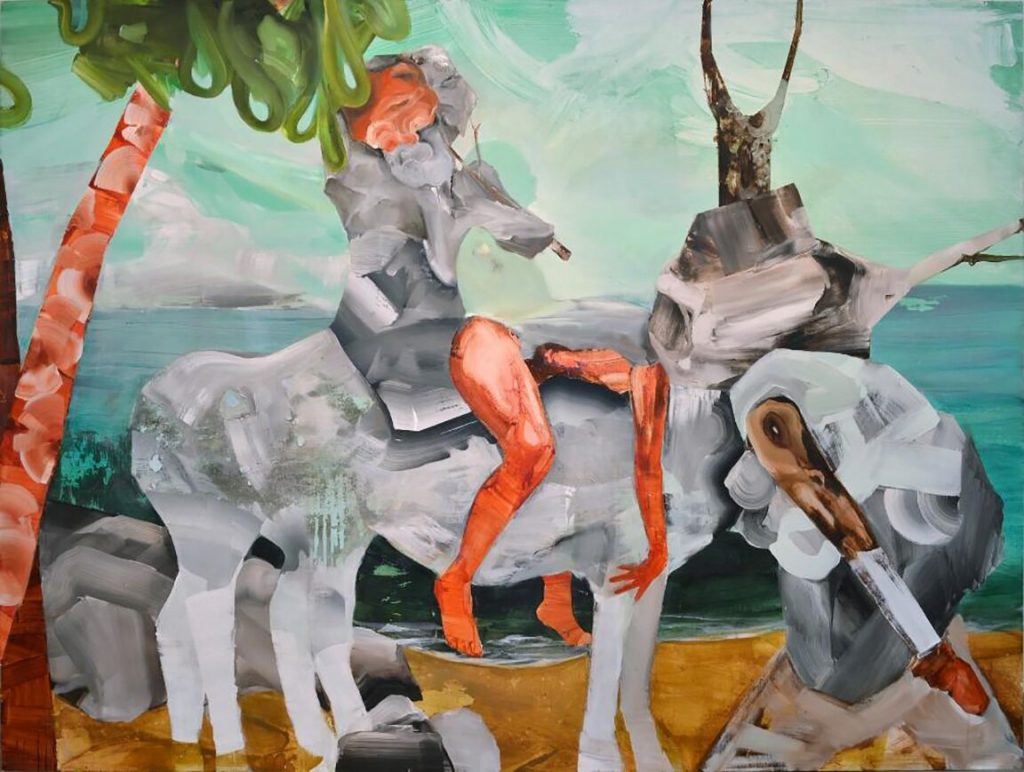 “Donkey bearing rock jelly” water dispersed pigment, acrylic, urethane and oil on panel, 72 x 96 inches, 2014 courtesy of the artist and P.P.O.W.
“Donkey bearing rock jelly” water dispersed pigment, acrylic, urethane and oil on panel, 72 x 96 inches, 2014 courtesy of the artist and P.P.O.W.
Where did you grow up?
I was born in Palo Alto, California and then moved with my family to New Orleans and then to Houston, Texas. I spent most of my time in Houston. Texas is another world; the landscape is wild. I’ve been in New York since 2007 so I do miss the wide open spaces. Driving across Texas is amazing, you can see and feel the landscape transform from a sticky swamp to a desert.
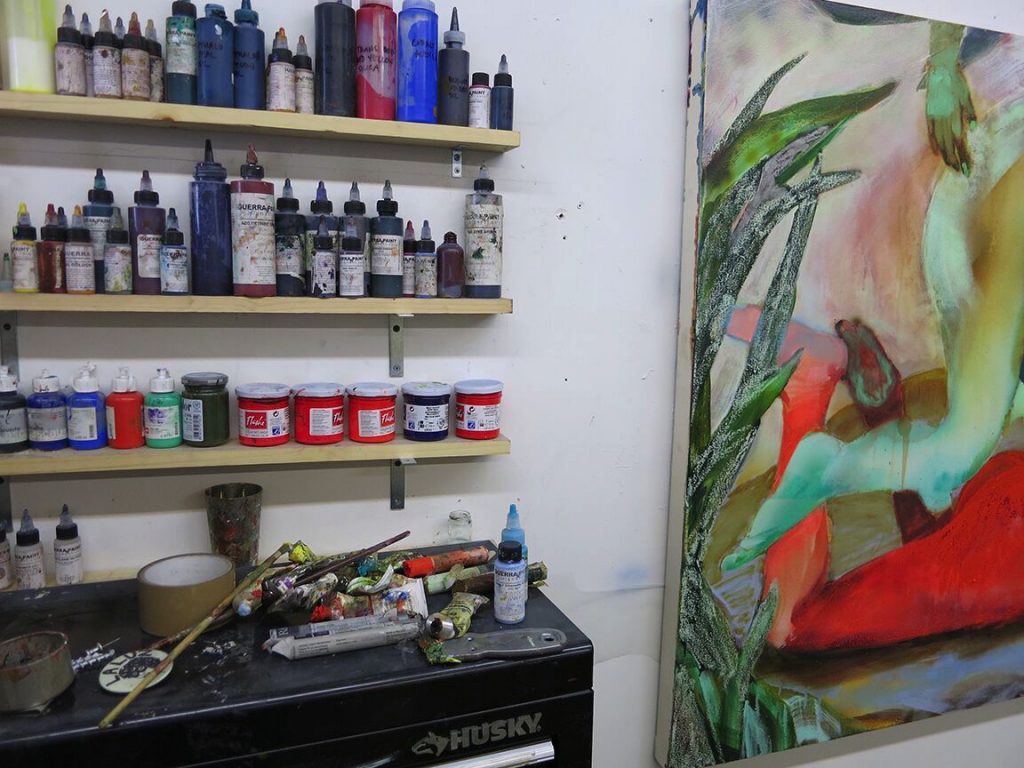
Houston also has a great art community. My mom is a painter, she taught at the Glassell School of Art, which is part of the MFAH (Museum of Fine Arts Houston). It offers classes like the Corcoran, but there’s no degree program. They also run a highly respected residency program called the Core program.
When I was in High school, I was on the Teen Council at the Contemporary Art Museum in Houston and one of the things we did was visit the Core artist studios. Trenton Doyle Hancock was a resident at the time, so we got to visit him there. That was a pivotal experience for me, everything in that space felt very alive and unreal in the best way and you could see that he was living his work. He was totally committed to what he was doing.
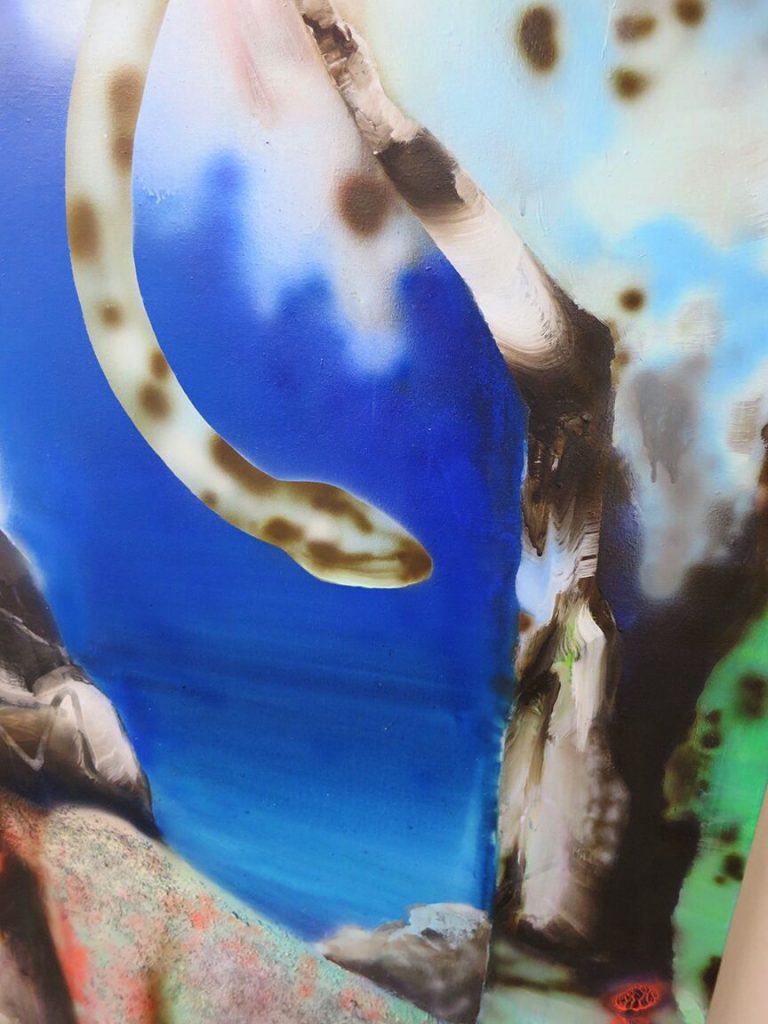 detail, work in progress
detail, work in progress
What is the driving force behind your work?
I feel like I couldn’t not do it. Growing up, it was the one thing I could always get lost in. I really enjoy the act of painting; I love that part as much as I love thinking about the ideas or the narrative.
When I am making, the small pieces especially, I reference things that I’m reading or experiencing now but then also combine that with things that have stuck with me from my past. So it feels like a natural way to reflect on the present and the past. I develop a lot of the stories in an intuitive way. With the pure act of painting the most exciting thing for me is trying something new and then being surprised with what happens. That allows for some of the content to be dictated by the process.
 studio view, work in progress
studio view, work in progress
What is your biggest struggle in the studio?
Right now it is the size of my working space. If I had more space, I might be doing more of the larger paintings at the same time. I like to work on a lot of pieces simultaneously. Sometimes there is a positive thing in not being able to though, it forces me to put things away, which stops me from overworking them.
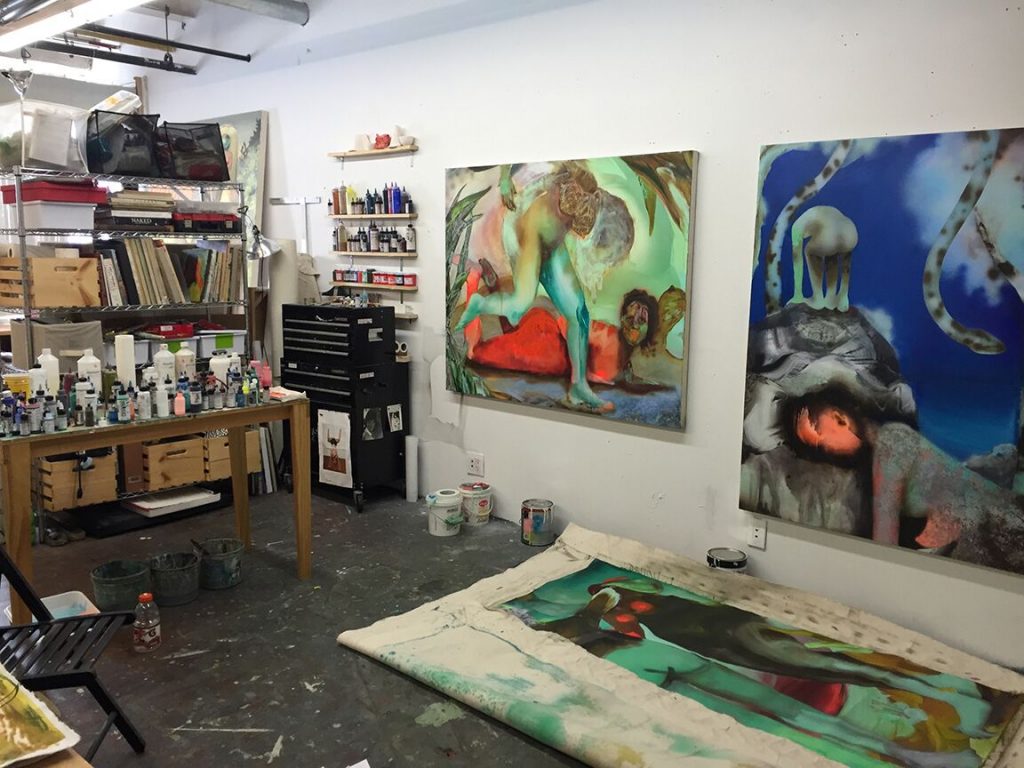 studio view, works in progress
studio view, works in progress
Put the following terms in order of importance to your studio practice:
Form, Concept, Process
I feel like they all inform each other. I have been thinking a lot about what I want the paintings to say but they aren’t extraordinarily specific. I am not totally interested in having an idea and then making a painting to show that idea. I start with vague ideas, I’ll think about a specific mood or particular landscape or color, then I start thinking about the narrative. I ask myself if it will be a dangerous painting or a lighter painting. They’re still open for people to experience them in their own way.
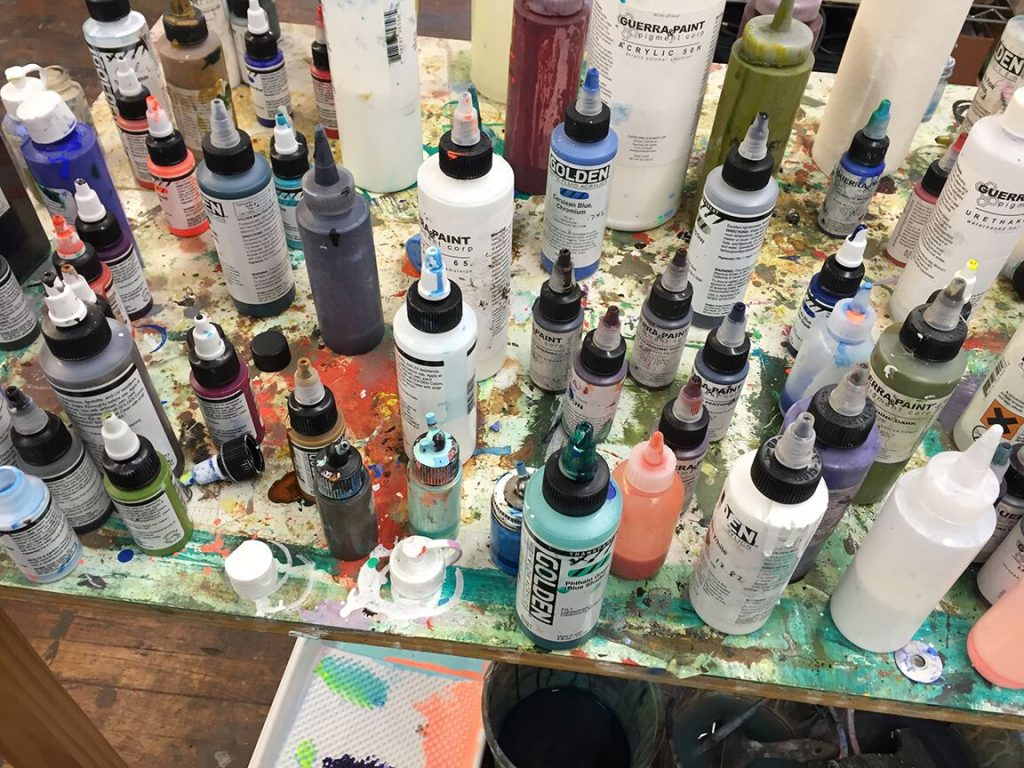
Was there ever a time when you felt like you couldn’t keep making work? If so, what helped you to keep going?
Yeah, there have been times when I question everything: the type of work I’m making, is the work important, etc. I’ve also had stretches where I fail a lot and I just keep making bad paintings. I make a ton of small pieces that no one sees. I was working on a huge piece earlier this summer, it’s a great example of a failure that took forever. It was haunting me. I would come in the studio and work on it every day and at a certain point I had to take it down, roll it up, and start new pieces.
This was my first large piece on canvas in a long time, and there was a lot of experimentation at the same time. I like to work fast and get it out and move on, but I got really stuck on this one. Sometimes I felt I had gone backwards that day, I would go home and obsess.
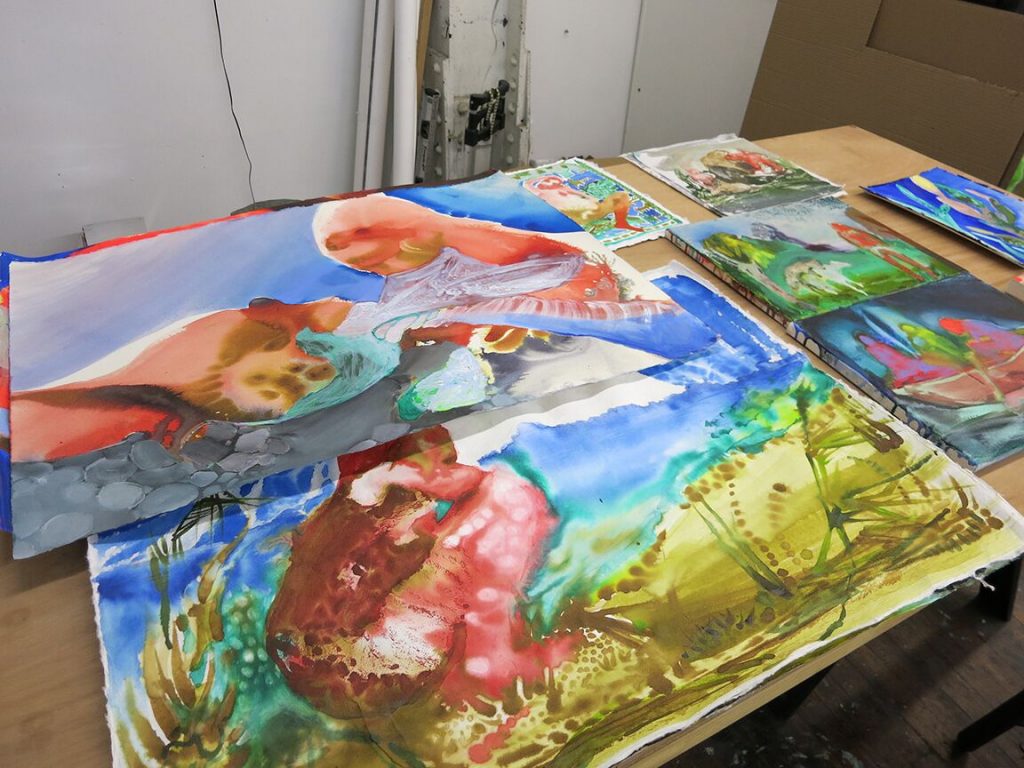
I take pictures in the studio and I would go home and look at the photos over and over again. I think a lot of it was figuring out how the materials I am used to working with on paper or panel worked on the canvas. I love working on paper, it is an amazing surface. Even though it takes a long time to prepare, it didn’t feel as daunting as painting on canvas.
I love the way wet media works on paper too, so when I was working on panel, that felt like the closest thing to the smooth surface of hot press paper. Canvas is more flexible, so when I wanted to bring some of the moments that occur in my other work into the large piece, it was a struggle. I learned that sometimes I’ll build up too much and then the piece dies. I just have to approach it differently. I put it away and work on something else, that’s how I deal with it.
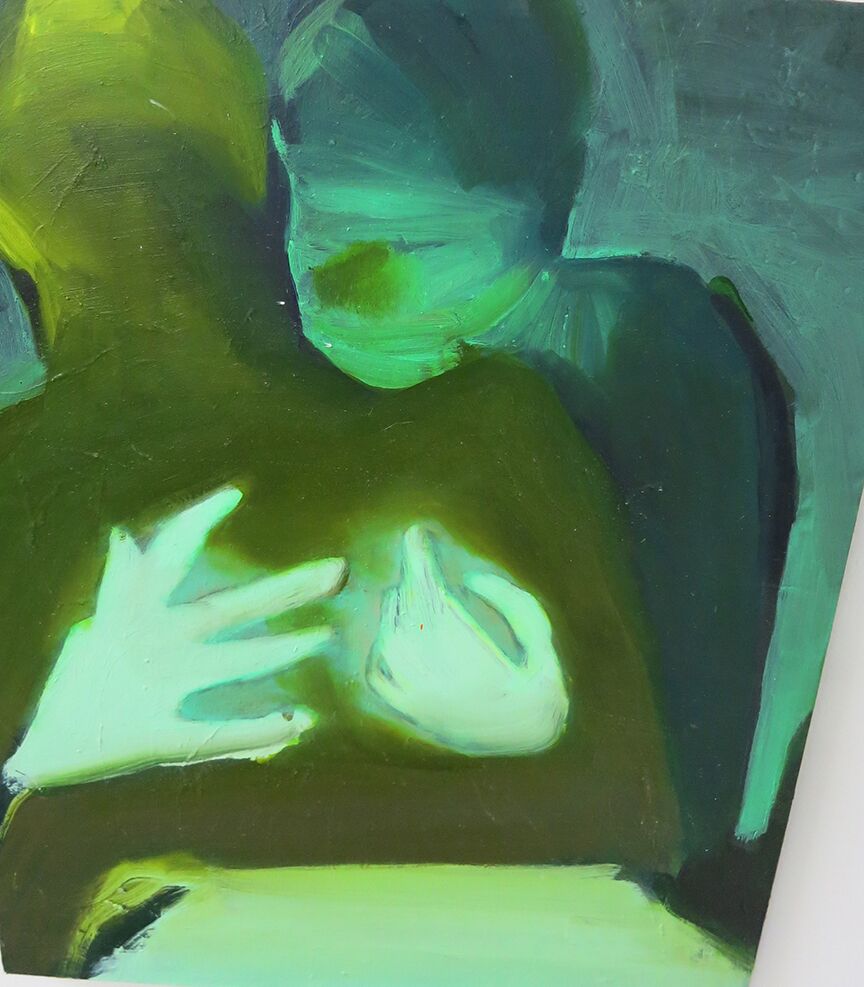
Do you have any routines, rituals, or coping mechanisms that you use regularly in your studio practice?
If I am frustrated with a big piece, I will just sit on the floor and work on small pieces on paper. That feels like, comfortable, play time. I think that kind of stuff impacts my work a lot. Sitting on the floor I am immediately reminded of childhood, which can be very freeing. I also have a big table at my apartment, and sometimes do small pieces there, which is a totally different environment. It’s nice to go back and forth.
My studio mate and I usually listen to music and podcasts (though when I’m by myself it’s always music, I can’t really focus on anything else while I’m working). Every once in a while I’ll be listening to a weird station on Spotify and turn it off and realize that the music was putting me in a weird mood.
If I’m really focused, it all becomes white noise so I don’t immediately realize how it is affecting me. I like listening to This American Life outside of the studio, and recently I had it on while painting. This episode that was so fucked up, I had to turn it off and listen to it later. It was too intense.

Do you have any hobbies or interests outside of your studio practice that help keep you sane?
I run. I have been running forever, I used to run track in high school and my first year of college but it became too much with practices. I don’t do incredibly long distances but I need to do it or I become a terrible person to be around. Because I work a lot on the floor I have been noticing I’m getting back aches and pain, so I think it’s important to be physical. I’m also in a book club/crit group with some amazing artists and writers.
A friend of mine, Jessica Stoller, who went to Cranbrook started this womens crit group with a few of the other members while she was there and a lot of them ended up in New York. They’ve kept it up here and it keeps growing. We go to one person’s studio one day and then do the book club another day. We’ve read one of the Elena Ferrante books, a scandalous book called Tampa and just finished Americanah, which is probably my favorite book so far. The author, Chimamanda Ngozi Adichie, is an incredible writer.
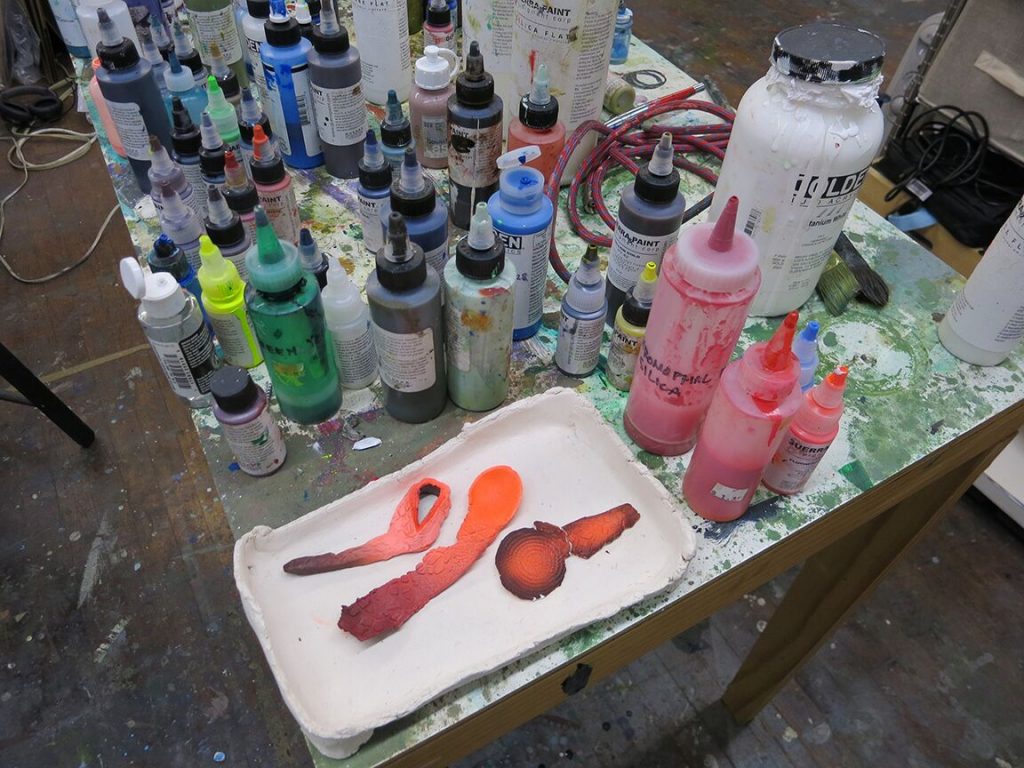
We, as artists, are doing so many different things. We have our home life, our studio practice, day jobs, etc. and I think that if I don’t make borders or boundaries I will just feel completely overwhelmed. So my day job is completely separated from my studio practice. But home life/studio life is a gray area for me. I have not yet learned how to not let my art affect my mood outside of the studio.
Is there anything you would like to promote? Upcoming exhibitions, projects, passions?
I just had several small works on paper up in a group show at P.P.O.W. curated by Anneliis Beadnell. I’ll have a couple of pieces in some group shows coming up. One at SVA curated by Peter Hristoff and another in Chinatown. I’ll send out an email and post something on Instagram when it gets closer to the dates.
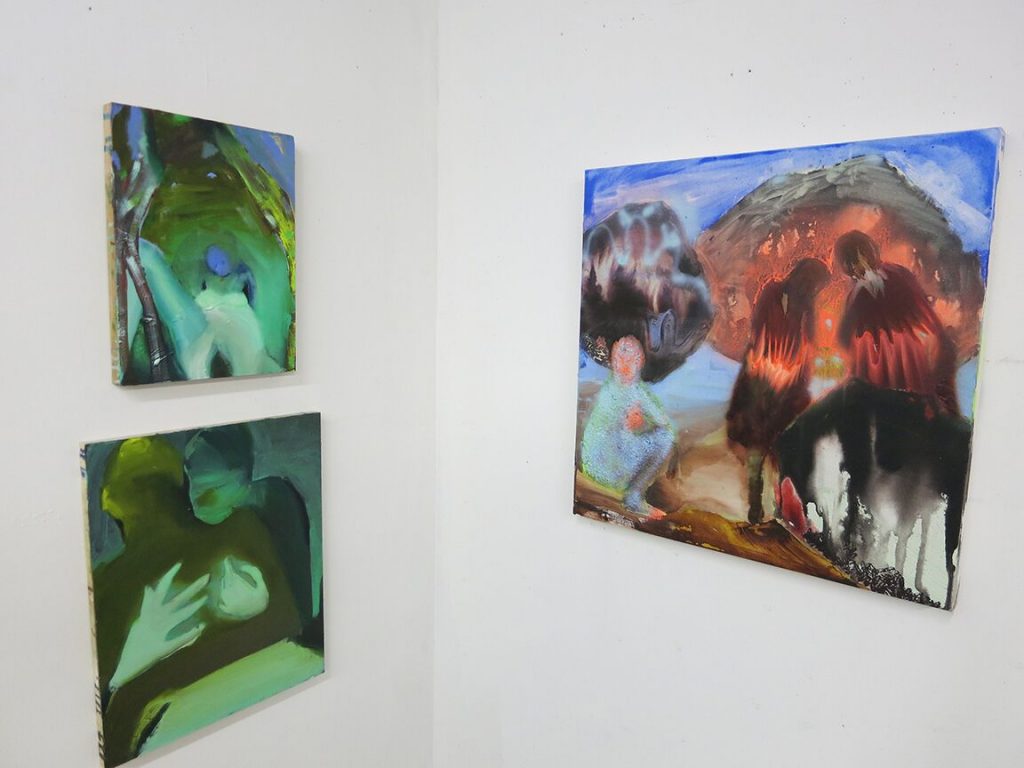
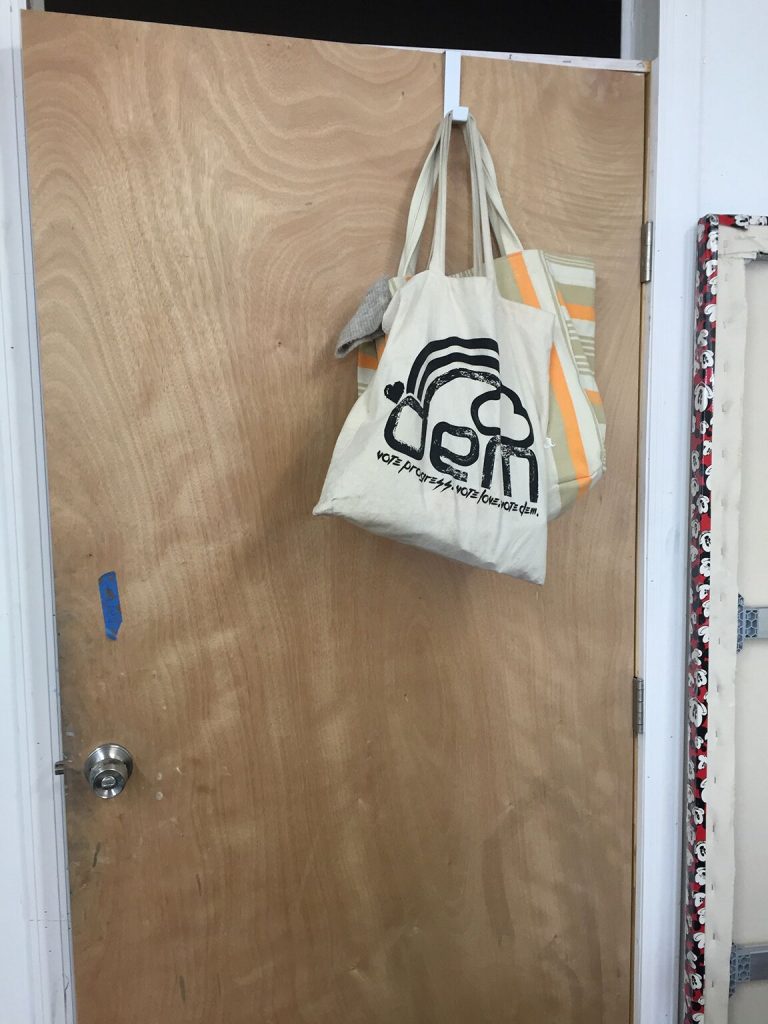
Bag from artist run Hillary rally called humboldt for hillary where I donated a piece for auction in support of her campaign. The image was created by Wendy White and it was screen printed on-site by Leslie Diuguid with Kayrock screen printing.
*****

Keep Going: Inertia is a monthly studio visit blog series that aims to make use of a consistent model and series of questions for visual artists. The content of the studio visits will highlight the struggles of a regular studio practice and the drive to keep working. National and International artists are to be featured to examine different approaches to working as a contemporary artist. Inertia will deliver the content through a compact and easily consumable format, allowing visitors to engage regularly and reliably.
Author Amy Boone-McCreesh is a Baltimore-based artist, writer, and professor.

